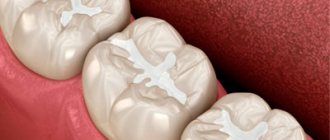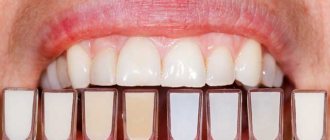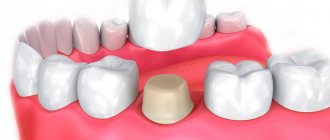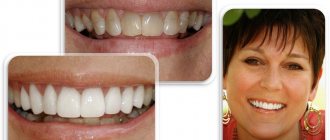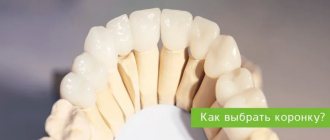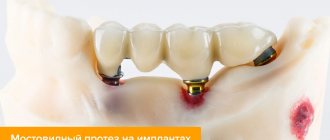Have you had to replace old fillings installed several years ago? Do you know what this threatens?
We will tell you how to avoid frequent replacement of fillings by using another dental restoration technology. In the article Filling, inlay or crown? We reviewed different methods of dental restoration, and today we will tell you in detail about the advantages of inlays .
An inlay is a filling made in a dental laboratory from filling materials, metals or ceramics.
Restoring a tooth with an inlay is more expensive than with a regular filling, and to understand whether it’s worth paying more , let’s figure out why an inlay is better than a filling. The benefits of inlays become obvious if you understand the reasons for replacing old fillings.
Let's start with the functions that the filling performs.
Material shrinkage is one of the reasons for replacing old fillings
Protection of the tooth from infection is ensured by the tightness of the connection at the border of the filling with the tooth tissue. Modern adhesive compounds reliably glue the filling to the tooth, but sometimes this can become a problem.
During curing, any material decreases in volume ( shrinks ) and filling material is no exception. By shrinking, the filling “pulls” on itself the parts of the tooth to which it is securely glued, and if the area of the filling is large, this force may be enough to cause cracks and chips to appear.
secondary caries forms at the site where the filling is torn from the tooth tissue .
Shrinkage of the filling material also poses other problems:
- with vertical shrinkage, the height of the bite changes, which leads to dysfunction of the temporomandibular joint and improper load on the filled tooth. As a result, the tooth may become damaged and require a crown to be installed to restore it.
- shrinkage of the filling horizontally leads to the disappearance of the contact point (point of contact) between adjacent teeth and stuck food puts pressure on the periodontal papilla, injuring it. The gums become inflamed, gingivitis, periodontitis and secondary caries develop.
When a restoration needs to be replaced (Conclusions)
A composite restoration must be replaced if: it changes its natural color, wears out, loses its shine, has a poor marginal fit, chips, cracks, or fractures.
The translation was made specifically for the OHI-S.COM website. Please, when copying material, do not forget to provide a link to the current page.
Bibliography
- Taviloglu. An Atlas Of Composite Applications, Quintessence Turkey.
- Manauta J, Salat A. Layers: An Atlas of Composite Resin Stratification. Quintessence Pub.
- Mangani - A. Putignano - A. Cerutti, Guidelines for Adhesive Dentistry.
- Krueger - Janson, 3D Composites
https://styleitaliano.org/
What are the consequences of insufficient filling strength?
The technology for making a filling (in the patient’s mouth) does not make it as strong as possible, so over time the filling material wears out.
As in the case of vertical shrinkage, abrasion of the filling can lead to problems:
- the level of bite changes , and this can lead to the chipping of part of the tooth due to the redistribution of the chewing load from the filling to the walls of the tooth.
- the boundary between the filling and the tooth tissue changes , while the filling loses its tightness and the infection penetrating inside provokes the development of secondary caries.
Is a refilling necessary if nothing bothers me?
Many patients are surprised when a dentist recommends replacing an old filling with a new one, because they have no pain or other unpleasant symptoms. However, replacement is carried out not only in cases of severe inflammation, but also for preventive purposes, as well as to improve the aesthetics of the dentition.
Like any other material, the filling mass is subject to gradual wear, deformation, and destruction. Hygienic care, oral microorganisms, saliva pH, mechanical, chemical and temperature effects of food over time provoke the appearance of microscopic cracks in the filling. The resulting pores serve as a breeding ground for microbes and the development of dental diseases.
Other disadvantages of the filling and reasons for replacing it
- Inaccurate anatomical shape of the tooth.
Restoring the correct shape of a tooth in a patient’s mouth is a difficult task. This work requires the dental therapist to have a good knowledge of anatomy and the skill of a sculptor. But even with these skills, it is difficult to model the shape of a tooth in hard-to-reach places.Inaccurate tooth shape is the cause of malocclusion (especially if there are a lot of fillings). Teeth grind food incorrectly, causing discomfort when biting, headaches appear, teeth are injured in the process of chewing food and are destroyed over time.
- Overhanging edges of the filling.
If, when installing a filling, the material flows onto the gum and rests on it, this leads to permanent injury and inflammation of the gums.A filling installed with such a defect causes local periodontitis and secondary caries, since it is difficult to remove stuck food from the resulting “pocket.”
- Difficulty in thoroughly sanding surfaces .
In places of contact with neighboring teeth, it is impossible to completely get rid of the roughness of the filling, and dental plaque adheres well to such a surface. - Development of caries at the interface between tooth and filling . The gradual shrinkage of the filling material and the destruction of the adhesive connection makes the border between the tooth and the filling the most vulnerable place where secondary caries develops first.
- Changes in the color of the filling material and tooth tissue over time make the border of the filling too noticeable.
Why does caries develop under the filling mass?
The development of a carious process under the filling material is often observed due to poor-quality treatment of the tooth cavity during treatment. The remains of the affected tissues serve as a source of infection, which intensifies and covers increasingly larger areas of the dentition unit.
Caries can also form if the filling is carried out in violation of the protocol. An incorrectly applied composition quickly becomes unusable, losing its fixation with the walls of the tooth cavity or collapsing under the influence of the aggressive environment of the oral cavity. Microbes penetrate into the resulting cracks and voids, which “trigger” the destructive process.
Another factor that provokes the development of caries is the natural “aging” of the filling. The appearance of microdamages (and micropores) on it and in it, which is inevitable over time, contributes to the accumulation of pathogenic bacteria, their reproduction, and the occurrence of recurrent disease. Therefore, it is advisable to replace old fillings with new ones after their expiration date.
What does replacing a filling lead to?
What's wrong with changing the filling when needed? The problem is that you don’t know the exact time when the old filling stops performing its functions, but if part of the tooth breaks off, the doctor will be forced to put in a new, larger filling.
In the case of advanced caries and pulpitis, it may be necessary to remove the nerve, but a “dead” tooth is more fragile and fillings and inlays adhere less well to its tissues (which means the service life will be shorter).
We devoted the article Karis to the treatment of different stages of caries: what is it like? And why does treatment differ so much in price? Read it to understand how caries progresses.
With each filling replacement, the “native” tooth becomes smaller and the moment approaches when it can only be restored with a crown.
How does the replacement take place?
Many patients are worried: is it painful to change a filling? The procedure is performed under local anesthesia and is therefore absolutely painless.
In general terms, re-sealing occurs as follows:
- anesthesia is administered
- the desired tooth is isolated from the oral cavity with a rubber dam: so that moisture and microorganisms do not enter the treated cavity,
- old filling material and tissues affected by caries (if any) are removed
- the cavity is treated with a special etching solution and dried,
- an insulating or medicinal pad is applied,
- a new filling is applied.
Restoration takes place with mandatory consideration of the anatomical features of the chewing surface.
Why is a ceramic inlay better than a regular filling?
Unlike a filling, which a doctor makes in the mouth, an inlay goes through all stages of manufacturing in a dental laboratory. The dentist only processes the tooth cavity under the inlay and makes impressions of the jaws, and after making the inlay, glues it in place.
Restoring a tooth with an inlay requires two visits to the dentist, but ensures long-term functionality and aesthetic perfection of the restoration.
Advantages of ceramic inlays:
- Inlays do not shrink after placement because this process is completed during the manufacturing stage in the dental laboratory.
- Ceramic inlays have the highest strength and do not wear out over time, thanks to production technology. The inlay is pressed from a ceramic mass heated to high temperatures or machined from a single piece of ceramic.
- Inlays completely restore the anatomical shape of the tooth and chewing functions, thanks to the modeling of the bite in the articulator using casts of two jaws.
- Making an inlay with fitting on a plaster model makes it possible to create it without overhanging edges , restore tooth defects in hard-to-reach places, ensure correct interdental contact and good marginal fit of the inlay to the tooth. All this is difficult to do when making a filling in the oral cavity.
- All outer surfaces of the inlay (including those in contact with adjacent teeth) are perfectly ground before installation.
- It is easier to select the desired color and translucency of the inlay in the laboratory than in the patient’s mouth. Therefore, ceramic inlays are the best option for aesthetic dental restoration.
- The inlay is more reliably glued to the tooth, since the doctor requires a minimum of time to install an inlay of exactly the right size into the treated tooth cavity (due to the speed of installation, the risk of moisture and infection on the treated surfaces is reduced).
By restoring a tooth with a ceramic inlay, you get a high-quality, durable restoration and do not get tired during the appointment, since you do not need to sit for a long time with your mouth open.
For medical reasons, if the coronal part of the tooth is destroyed by more than 30%, it is recommended to install an inlay.
Modern filling materials
In modern dentistry, a new generation of light-polymer materials is used, which have replaced the old cement, acrylic, and amalgam fillings. Their characteristic features are:
- high degree of strength;
- long service life;
- excellent aesthetic indicators;
- strong adhesive adhesion;
- Can be used on all teeth.
New generation fillings
Zinc phosphate, glass ionomer zinc eugenol filling cements differ from previously produced ones:
- increased strength;
- wear resistance;
- high aesthetic indicators.
Composite and ceramic inlays
They are made from individual impressions, which the doctor takes from the patient’s teeth. Inlays are used when more than 50% of the tooth is damaged. They can be restorative and stump. The first ones are used to restore the shape of the tooth, the second ones are used for further installation of crowns on them.
Crowns
In cases where simply replacing the filling is no longer enough, crowns are used. We can say that the crown is the last line on the path of tooth destruction. The next step is the removal and subsequent installation of a bridge, which threatens the integrity of the adjacent dental units, which are to be ground and serve as a support for the prosthesis, or the implantation of a titanium root.
To avoid giving dental caries and related diseases a chance, don’t forget to periodically make an appointment with your dentist. At the Plomba family dentistry clinic, you will be treated by specialists with many years of experience who have modern materials and technologies at their disposal.
Types of ceramic inlays
- inlay tab - restores the “cavities” of the tooth crown
- onlay tab - restores most of the chewing surface of the tooth crown
- overlay tab - restores the chewing surface and side walls of the tooth crown
The service life of the inlays is more than 10 years, while the filling will require replacement after an average of 5 years.
Now, when a dentist suggests restoring a tooth with an inlay, you know what benefits this will provide in the future.
How long can a filling last?
The service life of a filling is determined by several factors, the main ones being the following:
- correct installation and size,
- characteristics of the material from which it is made,
- the condition of the abutment tooth, the thickness of its walls,
- features of hygienic care: brush hardness, abrasiveness of pastes, etc.
- the presence or absence of certain habits: for example, high consumption of nuts, seeds, opening corks with teeth,
- the predominance of solid and/or tough foods in the diet, and so on.
As a rule, the minimum service life is 3-5 years, but some materials can last 10 years or more. In fact, it depends more on the condition of the treated tooth itself after a while.
Why does a tooth hurt after root canal filling?
| Type of complication | Description | Pain symptoms |
| Root perforation | As a rule, this happens when installing a pin into root canals, when its tip breaks through the root walls and rests on the bone tissue. The patient requires quite complex rehabilitation, otherwise there is a high probability of developing an infection. | Severe aching pain that can extend beyond the tooth. |
| Underfilling | A cavity remains in the root canals, which is not filled with filling material. This can lead to inflammation and abscesses. | A slight aching pain in the early stages and a strong (sometimes throbbing) pain as complications develop. Often after filling a tooth, the gums hurt. |
| Resealing | The material is planted too deep beyond the root tip. If its amount is insignificant, then over time it can resolve on its own. In more serious situations, resection of the root apex is required. | Prolonged aching pain up to neuralgia. |
| Fragments of tools in channels | A common medical mistake is when a piece of instrument remains inside the root canals. | From aching to sharp piercing pain when biting. If, after canal filling, it hurts to press on a tooth, this may also be one of the characteristic signs. |
When, after removing the nerve and filling, the tooth hurts during the first two to three days and the pain is pronounced, tell your dentist about it. In some cases, a quick response to the problem will help avoid serious complications.
Pastes
Almost all types of pastes can be easily removed using a regular solvent. First, using Girdwood burs and long round burs, and then Hedström files or new reamers, the filling is removed. If removal occurs from the canals, then it is necessary to know exactly the length of the tooth, which is done using x-rays. It is also necessary to irrigate the canal frequently to remove any sawdust that appears.
After the filling is removed, it must be replaced with a new one. The most common of them are a light (light-polymer) filling, which is most often installed on the front part of the teeth, a cement filling (zinc phosphate, glass ionomer, zinc eugenol), as well as an inlay.
How to put a filling on a tooth and avoid complications?
How to put a filling on a tooth and avoid complications after treatment? This question is often asked by patients to doctors, and it can be answered this way: always choose a clinic for dental treatment carefully, do not be lazy to find out its reputation among patients, and the level of qualifications of doctors working in the institution.
Only in a good clinic can you put a filling on a tooth without negative consequences for your health and with a guarantee of maintaining a positive treatment result for a long time!
If you got a filling and your tooth hurts, you shouldn’t always panic. When treating deep caries and pulpitis, mild pain may be normal for several days. But if the treatment was complicated, you had a nerve removed, a filling was put in, but the tooth hurts, and the pain is accompanied by a deterioration in your general health, a rise in temperature - immediately contact the dentist!
Such symptoms may indicate that the treatment was carried out poorly - for example, the tooth canals were not carefully treated, and the inflammatory process began to develop again.
You should also be wary if you have a filling installed, and the tooth hurts when pressed! This may indicate such errors in treatment as:
- Wrong choice of filling size;
- Low-quality material used in tooth filling;
- Improper preparation of the tooth for filling.
- In order not to encounter the complications discussed above and not to undergo dental treatment again, contact only clinics with an impeccable reputation. How can you find a clinic where you can get a high-quality filling for your tooth? It’s very simple: a good dentistry will have an informative website with reviews from patients, and its doctors will have diplomas, certificates and work experience.
Tooth pain after filling in questions and answers
Question: Can a tooth hurt after filling?
Answer:
Yes, especially after depulpation. This is not always a sign of complications, but it is worth seeing a doctor.
Question: What to do after filling a tooth?
Answer:
Follow the doctor’s recommendations and do not subject the treated tooth to heavy loads in the first days.
Question: How long does a tooth hurt after filling (classic)?
Answer:
If your tooth hurts severely for more than a day or two after getting a filling, tell your dentist as soon as possible.
Question: How long does a tooth hurt after root canal filling?
Answer:
In the absence of complications, a period of one to three days is considered normal (excluding severe throbbing pain). If your tooth hurts a week after filling (even if the pain is not too severe), be sure to consult a doctor.
Question: Is it normal to have tooth sensitivity after filling?
Answer:
After therapeutic manipulations, the sensitivity of the tooth may increase, but if after filling the tooth reacts to cold and hot with excessive pain, consult a doctor.
Question: How much can you not eat after filling a tooth with a light filling?
Answer:
It is not recommended to eat food within 1–2 hours.
Question: Why does a tooth hurt after filling when pressed?
Answer:
If there are complications in the form of inflammation and damage to tooth tissue, any mechanical impact will not cause the most pleasant sensations.
Question: What should I do if the tooth is swollen after filling?
Is it possible to place a filling without using an anesthetic?
It is, in principle, possible to place a filling on a tooth without the use of anesthesia, but only if we are talking about the treatment of non-advanced and shallow caries. If the tooth damage is significant, it is better not to refuse anesthesia!
Do not worry that the use of anesthetics may cause any harm to your health: the type of drugs and their dosage are selected individually for each patient. Using local anesthesia will allow you to place a filling on your tooth without pain, stress or discomfort!
If your tooth hurts after filling
So, why does a tooth hurt after filling? Any installation of a filling is an intervention in the tissue, so pain during and after treatment may well occur. On the other hand, one pain is a natural stage in the recovery of the body after treatment, and the other is a sign of incipient complications or injury. So when should you sound the alarm? Experts distinguish different types of toothache: according to duration, nature of manifestation and correlation with various types of manipulations.
